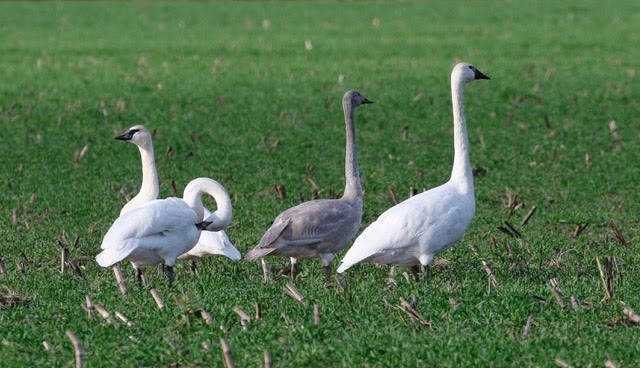Wintering trumpeter swans and occasional snow geese arrive around Thanksgiving to a warm welcome on the North Olympic Peninsula.
Their graceful white wings are unique, as well as their characteristic noisy flight calls! They can often be seen in family groups and larger flocks foraging in agricultural fields, pasture and wetlands around Sequim.
Trumpeter swans are the largest native North American waterfowl, and their conservation story is inspiring. Historically abundant, they were hunted for feathers and skins, and by 1935 the known United States population numbered only 69 individuals.
Conservation
Dedicated conservation, including protected status, habitat conservation and management, discovery of some remaining birds in Alaska, and reintroduction programs have slowly increased the total population to 63,000 individuals (Trumpeter Swan Society).
The Pacific Coast population of 24,200 breeds in Alaska and winters on the Pacific Coast, 11,700 are found in the Rocky Mountain population, and the Interior population of 27,055 is growing by virtue of reintroduction programs.
Trumpeter swans live about 25- 30 years, have single broods, and sexual maturity takes several years, so population growth takes time.
Although the Sequim Dungeness Christmas Bird Count (SDCBC) started in 1975, the first trumpeter swan sighting on the count wasn’t until 1982, with four swans. The swans were only recorded on five of the first 15 SDCBCs, very intermittent visitors.
Population
They have been recorded every year since 1989, slowly increasing. The count didn’t pass 50 swans until 2008, and didn’t pass 100 swans until 2016.
They are most vulnerable as cygnets. Adult swans have few predators and suffer mainly from collisions with power lines, and lead poisoning from ingesting lead birdshot.
The young remain with their parents in family groups until forming monogamous pair bonds of their own, usually at age 3 or 4. Males may not re-mate after losing their partner.
Some populations remain at risk from poor quality breeding habitat, and continued loss of wintering habitat, making it necessary to manage individual flocks and collect ongoing data.
In Sequim today, as many as 200 trumpeter swans are monitored closely by the Olympic Peninsula Audubon Society (OPAS) Swan study volunteers each winter in a community science project. Data are collected on weekly surveys of the swans’ daytime foraging areas and obvious injuries and mortalities, and shared with regional and national monitoring programs.
This OPAS study led to identification of power lines that pose collision hazards to the swans due to their proximity to fields and wetlands used by the swans. Those power lines have been marked with reflective tags the swans can easily see, and collisions seem to have decreased.
An update on the OPAS trumpeter and tundra swan study will be presented at the Wednesday, Feb. 19 OPAS membership meeting, which is open to the public. OPAS meets from 7-8:30 p.m. at the Dungeness River Audubon Center, 2151 Hendrickson Road.
Snow Geese
Snow geese are only occasional visitors to our area, preferring to socialize and forage in large flocks in the nearby Skagit agricultural area, where one can enjoy the astounding experience of seeing and hearing thousands of snow geese flying in enormous flocks.
The white geese are medium-sized, with black wing tips, and a distinctive dark “grin patch” on their bills, giving them the appearance of a smile.
Many of our regional Northwest Washington wintering geese breed in Wrangel Island, an Arctic Ocean island protected as a Russian nature reserve.
Snow geese are also monogamous, and family groups remain together until the young choose their mates in their second or third year.
Their life spans are about 25 years, and females return to the same nesting site and breeding colony every year.
Enjoy the “white wings of winter” in the North Olympic Peninsula, and rejoice at the successful recovery of the North American trumpeter swan populations.
To find out more about the swans, and birds in our area, explore the Olympic Peninsula Audubon Society website at olympicpeninsula audubonsociety.org.
Judith White is president of the Olympic Peninsula Audubon Society.



